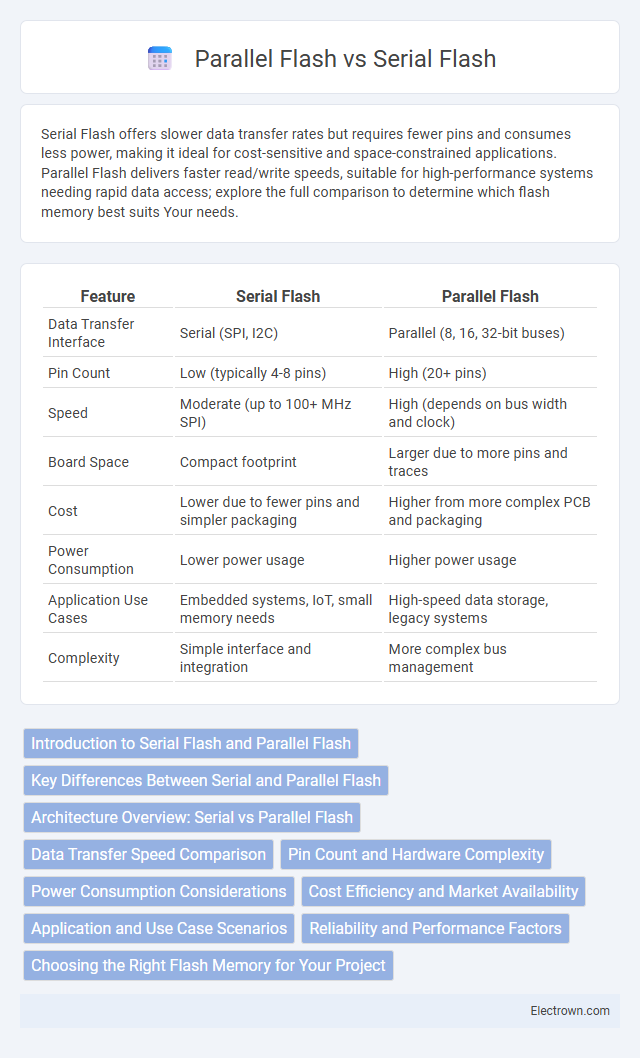Serial Flash offers slower data transfer rates but requires fewer pins and consumes less power, making it ideal for cost-sensitive and space-constrained applications. Parallel Flash delivers faster read/write speeds, suitable for high-performance systems needing rapid data access; explore the full comparison to determine which flash memory best suits Your needs.
Table of Comparison
| Feature | Serial Flash | Parallel Flash |
|---|---|---|
| Data Transfer Interface | Serial (SPI, I2C) | Parallel (8, 16, 32-bit buses) |
| Pin Count | Low (typically 4-8 pins) | High (20+ pins) |
| Speed | Moderate (up to 100+ MHz SPI) | High (depends on bus width and clock) |
| Board Space | Compact footprint | Larger due to more pins and traces |
| Cost | Lower due to fewer pins and simpler packaging | Higher from more complex PCB and packaging |
| Power Consumption | Lower power usage | Higher power usage |
| Application Use Cases | Embedded systems, IoT, small memory needs | High-speed data storage, legacy systems |
| Complexity | Simple interface and integration | More complex bus management |
Introduction to Serial Flash and Parallel Flash
Serial Flash memory transfers data one bit at a time over a single data line, offering a compact design and lower pin count, which makes it ideal for space-constrained applications. Parallel Flash memory transmits multiple bits simultaneously using multiple data lines, providing faster data transfer rates but requiring more pins and larger PCB space. Your choice between Serial and Parallel Flash depends on the balance between speed, size, and system complexity.
Key Differences Between Serial and Parallel Flash
Serial Flash uses a single data line for communication, resulting in slower data transfer rates compared to Parallel Flash which employs multiple data lines simultaneously, enabling faster performance. Parallel Flash requires more pins and consumes more board space, making Serial Flash preferable for compact, low-pin-count designs. Your choice depends on balancing speed requirements with hardware complexity and space constraints.
Architecture Overview: Serial vs Parallel Flash
Serial flash memory features a streamlined architecture with a single data line for transferring data sequentially, enabling simpler PCB design and lower pin count. Parallel flash employs multiple data lines transferring data simultaneously, resulting in higher throughput and faster access times ideal for performance-critical applications. The choice between serial and parallel flash depends on the balance between speed requirements, physical space constraints, and system complexity.
Data Transfer Speed Comparison
Serial Flash memory offers slower data transfer speeds compared to Parallel Flash due to its single data line architecture, typically achieving speeds in the range of tens to hundreds of megabits per second. Parallel Flash utilizes multiple data lines simultaneously, enabling significantly higher transfer rates often exceeding several hundred megabits per second or even gigabits per second in advanced configurations. This difference makes Parallel Flash more suitable for applications requiring rapid data access and high throughput.
Pin Count and Hardware Complexity
Serial Flash memory typically features fewer pins, often requiring only 4 to 6 pins, which significantly reduces hardware complexity and board space compared to Parallel Flash that can demand 20 or more pins. Lower pin count in Serial Flash allows simpler PCB routing and reduced manufacturing costs, making it ideal for compact, cost-sensitive designs. Parallel Flash's higher pin count and bus width complexity enable faster data access but require more complex hardware design and increased pin allocation.
Power Consumption Considerations
Serial Flash memory typically consumes less power compared to Parallel Flash due to its simplified interface and fewer data lines, which reduces active current during read and write operations. Your device can benefit from Serial Flash in low-power applications, especially where energy efficiency is critical for battery life extension. Parallel Flash may require higher power during operation because of simultaneous data line switching, making it less ideal for power-sensitive designs.
Cost Efficiency and Market Availability
Serial flash memory offers greater cost efficiency due to its simpler pin configuration and smaller package size, reducing manufacturing and assembly expenses. Parallel flash memory typically incurs higher costs because of its complex pin layout and larger PCB footprint, which increases material and production requirements. Market availability favors serial flash, with widespread adoption in consumer electronics and embedded systems, leading to diverse product offerings and competitive pricing.
Application and Use Case Scenarios
Serial Flash memory is widely used in applications requiring compact footprint and low power consumption, such as embedded systems, IoT devices, and consumer electronics where space and energy efficiency are critical. Parallel Flash memory finds its strength in high-speed data transfer environments like automotive control units, industrial automation, and legacy computing systems demanding rapid access and larger data throughput. Selection between Serial and Parallel Flash hinges on balancing interface complexity, cost, speed requirements, and physical size constraints specific to the target application.
Reliability and Performance Factors
Serial Flash memory offers higher reliability due to fewer data lines reducing signal interference and enhancing error resilience, while Parallel Flash provides faster data transfer rates benefiting performance in high-speed applications. Your choice should consider the trade-off between Serial Flash's lower pin count and power consumption versus Parallel Flash's superior throughput and latency. In mission-critical environments, Serial Flash's robust error correction mechanisms and simpler architecture often ensure more consistent performance under varying operating conditions.
Choosing the Right Flash Memory for Your Project
Serial Flash offers lower pin count and reduced board complexity, making it ideal for space-constrained and cost-sensitive projects, while Parallel Flash provides higher data transfer rates suitable for applications demanding fast read/write speeds. Selecting the right flash memory depends on balancing factors such as access speed, power consumption, and system architecture requirements, with Serial Flash excelling in low-power embedded systems and Parallel Flash favored in high-performance computing. Understanding these performance trade-offs ensures optimal integration and efficiency tailored to your project's specific storage and latency needs.
Serial Flash vs Parallel Flash Infographic

 electrown.com
electrown.com